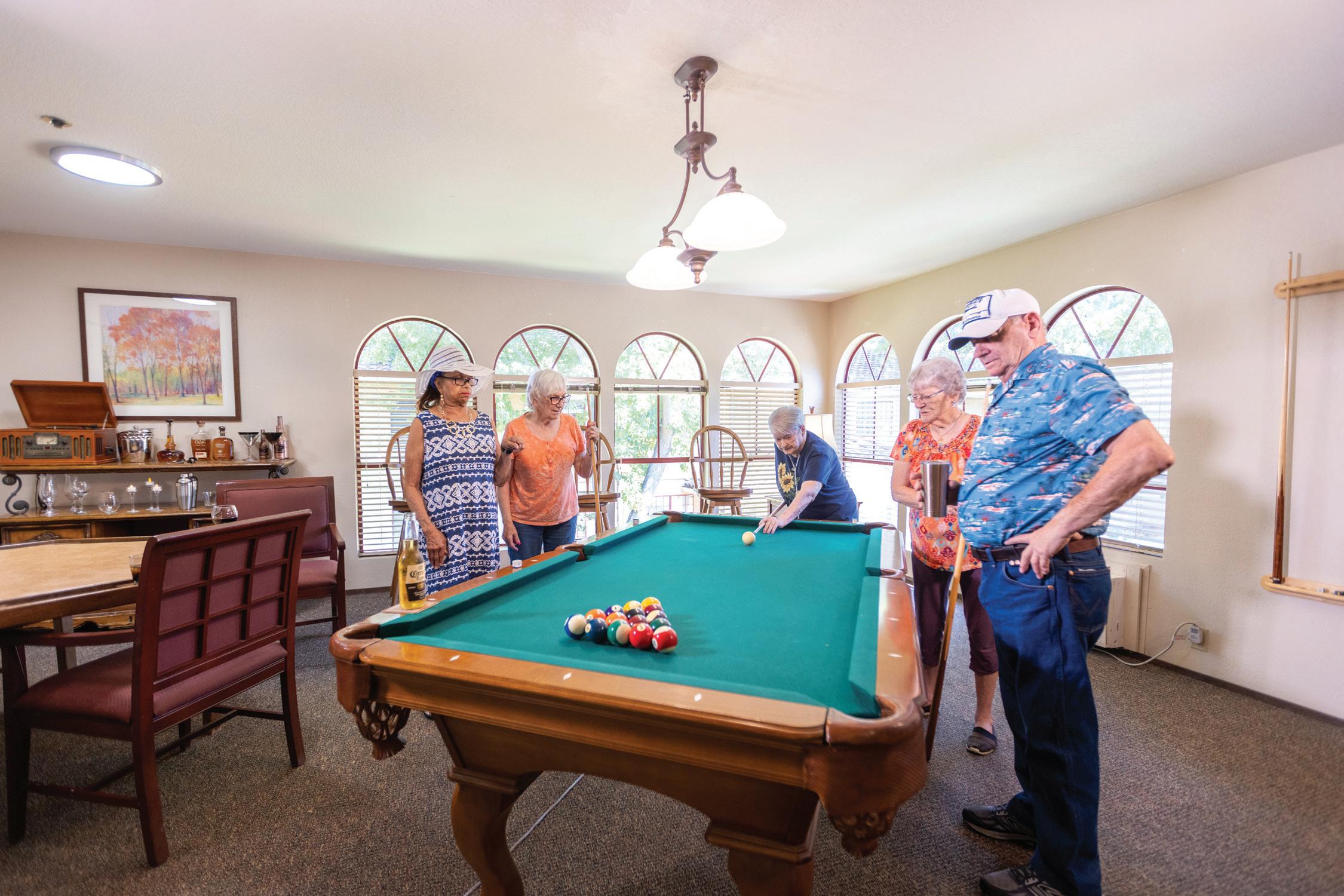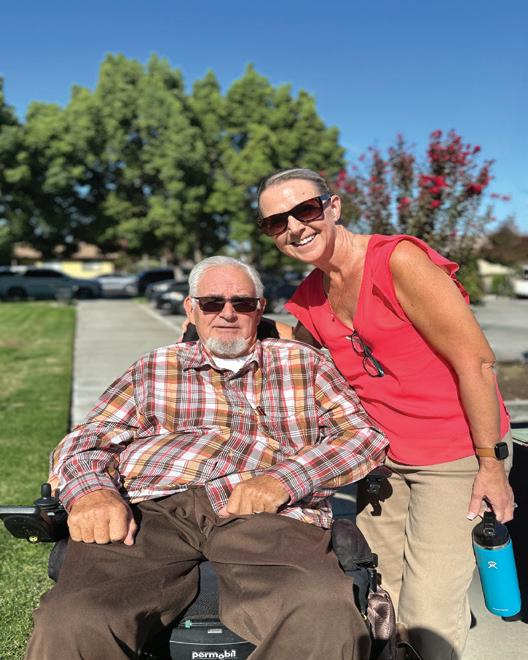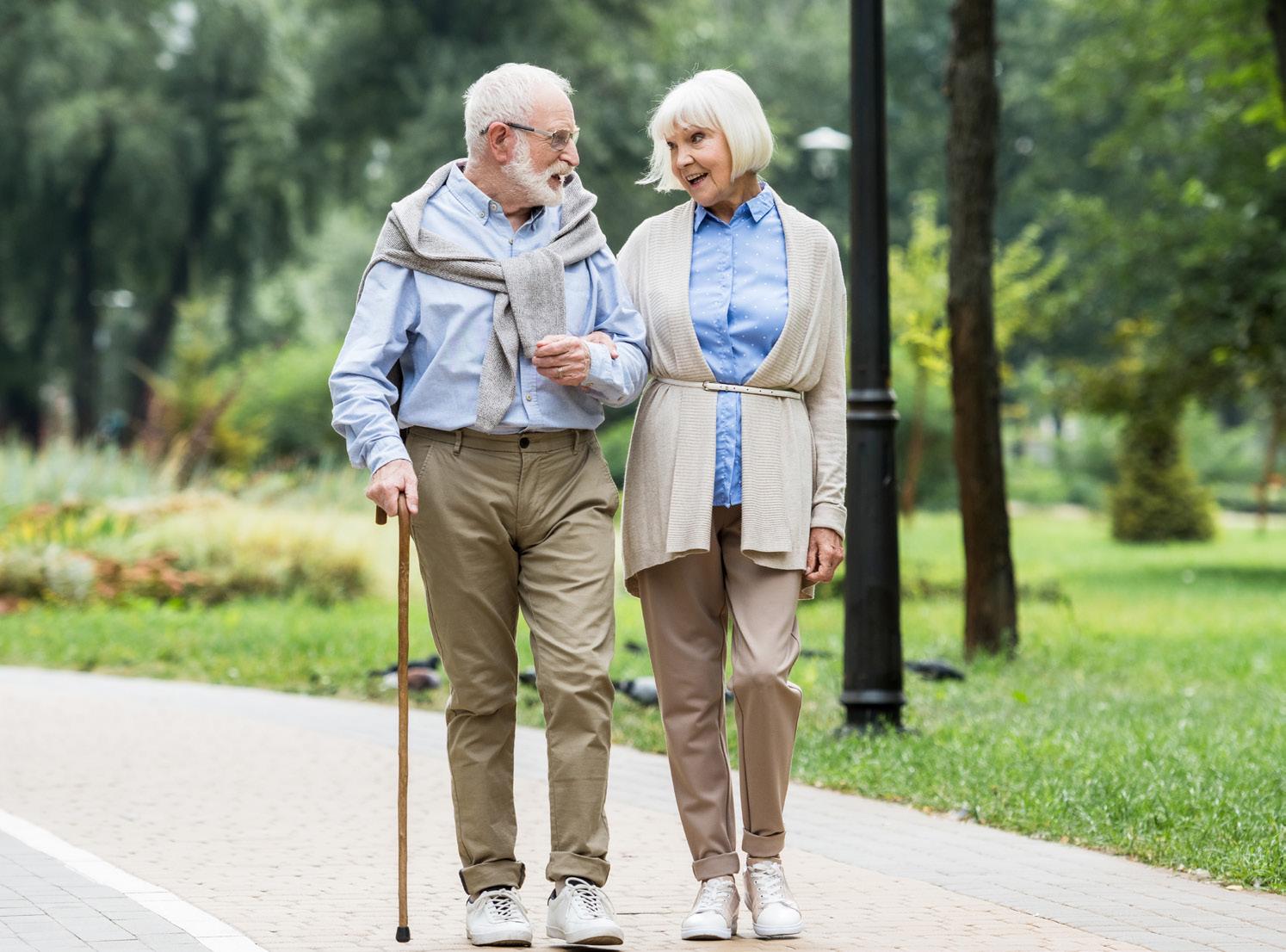SENIOR LIVING















































WE’VE LEARNED THAT ONE OF THE MOST IMPORTANT FACTORS IN LIVING LONGER AND FEELING BETTER IS HOW OFTEN WE GET MOVING.
Talk to your doctor about becoming more active, particularly if you are dealing with chronic health issues like diabetes, heart disease or obesity. Medical professionals can guide you toward exercises and everyday activities that are suited to personal goals but also take into account any individual challenges you may face. Here’s how to get going.
Once you’ve discussed things with your doctor and set an appropriate plan, take it easy during your initial exercises. This is critically important if you haven’t been active recently, as the risk of injury is greater. Start with small, achievable goals. That means two or three hours of moderate activity per week. Pay close attention to how your muscles and respiratory system react as you move through this new regimen. Be prepared to move things around if it’s initially difficult to fit regular exercise into your weekly schedule. Slowly add more miles, time or reps while allowing yourself plenty of time to
adjust and recover.
In reality, any activity that raises your heart rate is a net positive. This can be of particular comfort since you don’t have to join a gym or health club, lift weights or run on a treadmill in order to get in the recommended amount of exercise. Everyday activities like walking at a rapid pace, dancing, playing outside with your grandchildren, doing chores around the house and weekly lawn work are actually a form of exercise. You can take up yoga or begin balancing exercises from the comfort of home.
Thirty minutes of moderate exercise is recommended per day, according to the Centers for Disease Control and Prevention. This includes walking briskly. More vigorous activities like hiking, running or jogging should take up about 75 minutes of each week. Health.gov recommendations include doing muscle-strengthening exercises at least twice a week. If you don’t have access to resistance bands or weights, use water bottles or other household items. If you begin to feel chest pains, shortness of breath or any other nagging pain, immediately take a break and consult your doctor.



LONG BEEN ASSOCIATED WITH ROCKING CHAIRS AND SLEEPY SHUFFLEBOARD TOURNAMENTS — BUT NOT ANYMORE.
They’ve made engaging new upgrades as seniors began living longer, healthier lives. Here’s a guide for choosing a retirement community that fits your lifestyle.
Begin your research by focusing on what’s offered and how much it will cost. If exciting options for tennis, swimming or pickleball are offered, the community might be more attractive — but it also might be more expensive. Look for hair salons, exercise classes, libraries, gardens and music rooms, as well as laundry and concierge services. If they’re not on-site, look around to make sure they’re nearby. If their individual pricing doesn’t meet your comfort level, keep looking. There are often plenty of options since retirement options are such a fast-growing portion of our economy.
The best-run retirement communities help create and nurture a wider social circle through planned group activities. Remaining social is a critical part of good mental health for seniors, and it’s key to longer, more active lives. Make sure your potential community offers its residents lots of opportunities to interact with one another in an open, encouraging environment. You’ll build new friendships through activities like arts and crafts, board games and dancing. Ask about sponsored group outings where transportation is provided to local points of interest.

Ask about dining services if your idea of retirement is leaving the kitchen. Some communities may limit or restrict outside visitors, so carefully read their policy if you plan on spending extended time with friends and family. Many move into retirement with a treasured pet, but some communities don’t allow them. Feeling safe is also a large part of general well-being, so make sure that all proper measures are in place, including ample lighting, security cameras, emergency systems and plans, and a structured check-in area for visitors.
Finally, the community should be close to needed healthcare, including preferred doctors, a hospital and other needed service providers. Fun nearby activities like golf, swimming, shopping, libraries, churches and public transportation round out the experience. At the same time, be aware that proximity to sports facilities, highways and schools will also potentially lead to noise and traffic issues.


THE HOPE IS TO RETIRE WITH A LARGE ENOUGH NEST EGG THAT WE CAN LIVE A WORRY-FREE LIFE. IDEALLY, THERE WOULD BE AN INHERITANCE TO LEAVE AS A LEGACY.
Stretching your retirement dollars can be difficult, however, particularly for anyone who has tied these funds into the sometimes volatile stock market. Every financial decision is critical. Here’s how to make the right ones.
Annuities are an increasingly popular option in retirement planning because they offer a guaranteed income stream without regard to stock market fluctuations. In an era when Wall Street has been so unpredictable, this can be par-
ticularly comforting for retirees. These are essentially insurance products that are sold with fixed or variable options. You purchase the annuity and then see a return on investment over an agreedupon period of time. As long as the issuing company remains financially secure, your annuity is guaranteed. The downside of annuities is that your funds are locked into the investment: You will incur a stiff penalty for early withdrawal.
An increasing number of retired seniors are starting an exciting second career, exploring a different interest while making extra cash. These jobs are usually part-time and may be in a field related to your main career. Seniors may also choose to delve into something entirely new that has always been of
interest. In either case, having this additional income makes it easier to avoid dipping into savings during early retirement. You’ll also stay engaged and active — two critical elements in creating a healthier, longer life.
Don’t be afraid to seek out professional advice on money management and investments if you want to get the most out of your retirement savings. Get recommendations from family, friends and neighbors who’ve worked with financial advisors in the area. Do your own research into potential advisors, checking their reputation and certifications. Be wary of anyone who pressures you into buying a particular product. The best financial advisors individualize a plan in order to meet each client’s own

needs. Don’t let a hard-selling approach lead to a critical mistake. Instead, keep looking. There needs to be a level of trust in this relationship, since re-evaluations may need to be made along the way.
Valley Oak Dental Group is a multispecialty group practice committed to excellence.

Our Pediatric Department provides a comfortable, caring atmosphere for your children.
procedures



THE NUMBER OF AMERICANS AGED 65 OR OLDER IS AT AN ALL-TIME HIGH. ROUGHLY ONE IN EIGHT CITIZENS IS PART OF THIS DEMOGRAPHIC, THE ADMINISTRATION ON AGING REPORTS.
As Baby Boomers continue to move into retirement, these numbers are predicted to rise from about 13% of the total population to nearly 20% by 2023. At the same time, life expectancy rates have been at or near all-time highs. Credit goes to healthier lifestyle choices and amazing advances in medicine and health care.
The Centers for Disease Control and Prevention reports that medical breakthroughs played the largest role in rising life expectancy before the COVID-19 pandemic. In past years, seniors were more susceptible to chronic disease, infection and other previously fatal maladies. Vaccinations against dangerous viruses have led to declines in death rates worldwide.
Researchers have also learned more about how the role of heart disease, lack of physical exercise and poor diet can shorten life expectancy. Healthier living and other prescriptive aids have also helped transform the so-called “golden years” into a longer, more productive
period of time. Finally, a focus on safety has played a role, with critical improvements to our food, water, workplace and highways.
Meeting and then working to beat the average life expectancy takes focus and discipline. Seniors who consume a diet that’s low in processed foods, excess salt and fatty meats are part of this growing contingency of healthy, active people in their 80s and beyond. Researchers have learned that remaining highly social plays a part, as well. That may mean spending time with family and friends, joining a hobby group or participating in community events. These personal choices also contribute to your emotion-
al well-being and overall health.
Americans have generally been living much longer, but the Journal of the American Medical Association notes that struggles may remain on a personal level. Depression and loneliness are particularly widespread among seniors, and nagging issues like arthritis may impact our ability to take part in some daily activities. If you’re eating a healthier diet, have renewed your focus on social activities and exercise regularly but feel your quality of life is still lacking, reach out to someone. Family, friends, counselors and medical professionals can provide the support you need.






AS WE MOVE INTO OUR LATE 60S, MOST AMERICANS WILL FIND THEMSELVES ON A FIXED INCOME.
Retirement can be enjoyable and rewarding, as long as you remain healthy and have enough savings to cover expenses. You’ll want to make sure you’re ready through smart financial planning. This becomes even more important if a medical issue arises and you’re not adequately prepared to absorb the financial implications.
There can be catastrophic impacts if you were to outlive your nest egg or encounter an unexpected situation.
Preparing for these circumstances can be difficult while also ensuring that you can continue to live life to the fullest in retirement. That’s why it’s important to create a strategy ahead of time so that you’re ready. That may mean moving investments into lowerrisk mutual funds or bonds since higher-risk products present more nearterm risk for older investors. Consider diversifying your investments since there is also considerable risk associated with focusing on any single segment. Simply shift slightly toward new, but still safe investments. If you aren’t confident that you can pull off this delicate balancing act, get in touch with a reputable financial advisor. They’ll help you develop a personal
plan that works within your plans and goals.
For some, retiring at 62 or even 65 simply doesn’t make good immediate financial sense. Others may consider staying on the job to address worries about having enough in their nest egg. There are also targeted financial incentives given by some pension plans and Social Security for those who continue to work. Your decision might also be impacted by sharply rising interest rates, changes at work or costs associated with inflation. If you decide to stay on, be sure to continue making contributions to your
There are property tax relief programs for older Americans that are administrated by federal and state government agencies. In the meantime, energy assistance programs may also help you save money each billing cycle. Contact local representatives to find out more about options and eligibility. Seniors should also take advantage of special discounts available through retailers, grocers and even national parks. You may also consider downsizing to a condo or apartment in order to save on monthly rent and utility costs.




Hospice
Advanced

Caregiver



Falling is one of the biggest health risks facing older adults –every year three million seniors are treated in emergency rooms for fall-related injuries.
If you’re concerned about falling, either for yourself or a loved one, join us for a free webinar on fall safety on Friday, March 22 at 10am Pacific Time
The webinar will feature Mike Studer, a physical therapist who will present on the importance of balance and walking gait in preventing falls and discuss the fear and anxiety many older adults feel surrounding their fall risk.
for the free webinar at PrestigeCanHelp.com

AROUND 70% OF STROKE VICTIMS ARE 65 AND OLDER, ACCORDING TO SEVERAL STUDIES.
In some cases, this risk is beyond their control. But for others, a handful of key lifestyle changes can have a huge impact.
The Centers for Disease Control and Prevention lists genetics and certain conditions like heart disease and sickle cell are predispositions for stroke. These issues tend to run in families, so it’s important to know their history and any specific issues they dealt with. This information will help medical profes-
sionals develop a more individualized health maintenance plan. Genetics may predispose you to a stroke, along with certain health conditions like heart disease and sickle-cell disease, according to the Centers for Disease Control and Prevention. Knowing this information will play a vital role in how your doctor approaches any plan to maintain your health.
High blood pressure is another principal risk factor for stroke, which is why the U.S. Department of Health and Human Services describes keeping it in normal range as a preventive measure. Monitor cholesterol and blood sugar
levels, quit smoking (or never start), and stay on a regular checkup schedule. These routine tests can help determine your immediate stroke risks. Doctors may also order specific tests, including a carotid ultrasound that identifies cholesterol-related plaque buildups in the neck area. This is a key issue leading to strokes.
Depending on your level of daily activity and body mass index, nutritional experts recommend no more than 1,500 to 2,000 calories a day. Reduce salt intake to a half teaspoon or less per day. Stay away from saturated fats, while instead consuming 4 to 5 cups of fruit and vegetables each day. Limit daily
alcohol intake to one glass or less.
There are specific signals that indicate stroke, so be on the lookout with friends, family and yourself. The National Institutes on Aging notes that these signs include numbness or weakness in the arm, leg or head — particularly on just one side — as well as a sudden inability to speak coherently, the fast onset of vision problems in one or both eyes, and a severe headache that happens for unknown reasons. Familiarize yourself with these symptoms and be prepared to call 9-1-1 immediately. Acting fast is critically important.







OUR BODIES NATURALLY DEVELOP DIFFERENT NEEDS AS THEY AGE. UNFORTUNATELY, ONE STUDY FOUND THAT AS MANY AS A THIRD OF SENIORS LACKED SOME BASIC NUTRITIONAL REQUIREMENTS — PARTICULARLY WITH CRITICAL VITAMINS B AND D.
Focusing on specific foods can often address these issues, leading to better overall health. But supplements may be required, particularly if deficiencies linger. Just be sure to consult your physician before starting or increasing vitamin supplements.
Everything we eat impacts how we feel and how well our bodies function. If eating a healthy diet, as prescribed, many seniors will naturally absorb the vitamins required for good health. Fruit, whole grain and vegetables are packed with various needed vitamins. Grains, for instance, are a great source of B vitamins. Focus on consuming a diet that balances proteins, carbohydrates and healthy fats, and the typical senior will be in good shape.
As we age, however, our stomachs begin producing less acid, and that can reduce the ability to absorb important nutrients including iron and vitamins B6 and B12. Adults who are 50 and older should pay close attention to their levels, even if their diet remains the same. At the same time, seniors may lose more minerals like calcium than they absorb. Bones can break more easily, especially with postmenopausal women.

In addition to these health benefits, vitamin-packed diets can lower the risk of certain diseases. For instance, the Alzheimer’s Association reports that vitamin E is thought to be a preventative, particularly in combination with vitamins C and B12 and folate. Cold-water fish, vegetables, darkskinned fruit and nuts are the association’s recommended foods.
The recommended daily allowance for vitamins has been set by the Food and Nutrition Board of the National Academy of Sciences, and can be found right on the labels of food products. They’re also part of the labeling for supplements. But some seniors — and particularly women — may have other needs not specifically outlined in these general guidelines. Talk to a doctor, nutritionist or other health care professional about your diet. Testing may also be appropriate. They’ll make their recommendations based on your individual diet, health condition, weight and other factors.











Mohammad Pathan M.D Joseph Zeiter Jr. M.D. John Canzano M.D. RichardWong M.D. John Zeiter M.D. Joseph Zeiter M.D.
Mohammad Pathan M.D Joseph Zeiter Jr. M.D. John Canzano M.D. RichardWong M.D. John Zeiter M.D. Joseph Zeiter M.D.
John Canzano M.D. RichardWong M.D. John Zeiter M.D. Joseph Zeiter M.D.
Mohammad Pathan M.D Joseph Zeiter Jr. M.D. John Canzano M.D.
Mohammad









Ralph Miranda O.D.
Ralph Miranda O.D.
Ralph Miranda O.D.
Krishna Patel O.D.
Krishna Patel O.D.
Krishna Patel O.D.
Katelyn Balancio O.D.
Katelyn Balancio O.D.
Katelyn Balancio O.D.




Erin Doxtader O.D.
Erin Doxtader O.D.
Erin Doxtader O.D.
Jennifer Pham O.D.
Jennifer Pham O.D.
Jennifer Pham O.D.